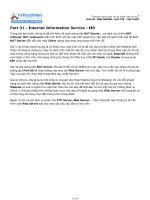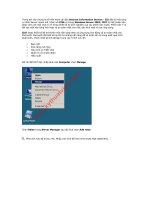Using Accounting Information Ex II
Bạn đang xem bản rút gọn của tài liệu. Xem và tải ngay bản đầy đủ của tài liệu tại đây (1.8 MB, 34 trang )
UsingAccountingInformation
ExercisesII
LarryM.Walther;ChristopherJ.Skousen
Downloadfreebooksat
Larry M. Walther & Christopher J. Skousen
Using Accounting Information
Exercises II
2
Download free eBooks at bookboon.com
Using Accounting Information Exercises II
1st edition
© 2011 Larry M. Walther & Christopher J. Skousen & bookboon.com
All material in this publication is copyrighted, and the exclusive property of
Larry M. Walther or his licensors (all rights reserved).
ISBN 978-87-7681-794-7
3
Download free eBooks at bookboon.com
Using Accounting Information Exercises II
Contents
Contents
Problem 1
6
Worksheet 1
6
Solution 1
7
Problem 2
8
Worksheet 2
8
Solution 2
9
Problem 3
11
Worksheet 3
12
Solution 3
13
Problem 4
14
Worksheet 4
15
Solution 4
16
www.sylvania.com
We do not reinvent
the wheel we reinvent
light.
Fascinating lighting offers an ininite spectrum of
possibilities: Innovative technologies and new
markets provide both opportunities and challenges.
An environment in which your expertise is in high
demand. Enjoy the supportive working atmosphere
within our global group and beneit from international
career paths. Implement sustainable ideas in close
cooperation with other specialists and contribute to
inluencing our future. Come and join us in reinventing
light every day.
Light is OSRAM
4
Download free eBooks at bookboon.com
Click on the ad to read more
Using Accounting Information Exercises II
Contents
Problem 5
18
Worksheet 5
19
Solution 5
20
Problem 6
21
Worksheet 6
22
Solution 6
24
Problem 7
26
Worksheet 7
28
Solution 7
29
Problem 8
31
Worksheet 8
33
Solution 8
34
360°
thinking
.
Discover the truth at www.deloitte.ca/careers
5
Download free eBooks at bookboon.com
© Deloitte & Touche LLP and affiliated entities.
Click on the ad to read more
Using Accounting Information Exercises II
Problem 1
Problem 1
Mr. Mac Corporation has no material problem with uncollectible accounts or obsolete inventory. All sales
and purchases are on account. he company provided the following information for the year ending 20X5:
Total sales
$ 1,560,000
Beginning accounts receivable
350,000
Total purchases of inventory
1,080,000
Beginning inventory
25,000
Collections on accounts receivable
1,440,000
Payments on accounts payable
925,000
Cost of goods sold
1,065,000
a) Calculate the “accounts receivable turnover ratio.“
b) Calculate the “inventory turnover ratio.“
c) If Mac’s competitors have a receivables turnover ratio of “7“ and an inventory turnover
ratio of “5,“ would you initially conclude that Mac is better or worse than its competitors in
managing receivables and inventory?
Worksheet 1
a)
Accounts Receivable Turnover Ratio
=
Net Credit Sales/Average Net Accounts Receivable*
=
b)
Inventory Turnover Ratio
=
Cost of Goods Sold/Average Inventory**
=
c)
6
Download free eBooks at bookboon.com
Using Accounting Information Exercises II
Problem 1
Solution 1
a)
Accounts Receivable Turnover Ratio
=
Net Credit Sales/Average Net Accounts Receivable*
=
$1,560,000/[($350,000 + $470,000)/2]
=
$1,560,000/$410,000
=
3.80
* Ending accounts receivable = $350,000 + $1,560,000 sales – $1,440,000 collections = $470,000
b)
Inventory Turnover Ratio
=
Cost of Goods Sold/Average Inventory**
=
$1,065,000/[($25,000 + $40,000)/2]
=
$1,065,000/$32,500
=
32.77
** Ending inventory = $25,000 + $1,080,000 purchases – $1,065,000 cost of goods sold = $40,000
c) Mac is doing much better than its competitors as it relates to managing inventory
(32.77 vs. 5), but is lagging behind as it relates to collecting receivables (3.80 vs. 7).
7
Download free eBooks at bookboon.com
Using Accounting Information Exercises II
Problem 2
Problem 2
Beverly Monson is the chief inancial oicer for Monson Construction. She delivered the following
comments in a recent conference call with analysts that follow the company:
“20X7 was another excellent year. Net income was a record setting $3,500,000. We maintained
our overall net proit on sales at the historic 15% level. his occurred despite an increase in
raw material costs that lowered our gross margin to 45%. We are proud that we continue to
maintain a healthy balance sheet that is free of any liablities. All of our inancing continues
to be provided by our common and preferred shareholders. Our beginning of year equity of
$65,000,000 was suicient to fund our capital needs, and no additional shares were issued this
year. Our “4% preferred shareholders“ have again received their full $1,500,000 in dividends
for the year. he remaining earnings have been reinvested in the company.“
a) Use proitability ratios to determine Monson’s sales, cost of goods sold, gross proit, and
net income.
b) Calculate Monson’s return on assets and return on equity. Which is higher, and why?
Worksheet 2
a)
Sales
Cost of goods sold
Gross proit
Selling, general & administrative
Net income
8
Download free eBooks at bookboon.com
Using Accounting Information Exercises II
Problem 2
b)
Return on Assets Ratio
=
(Net Income + Interest Expense)
÷
Average Assets
=
Return on Equity Ratio
=
(Net Income – Preferred Dividends)
÷
Average Common Equity
=
Solution 2
a)
Sales
100%
Cost of goods sold
55%
Gross proit
45%
Selling, general & administrative
30%
Net income
15%
$
52,500,000
$
23,625,000
28,875,000
20,125,000
$
b)
Return on Assets Ratio
=
(Net Income + Interest Expense)
÷
Average Assets
=
($3,500,000 + $0)
÷
($65,000,000 + ($65,000,000 + $3,500,000 – $1,500,000))/2
=
5.303%
9
Download free eBooks at bookboon.com
3,500,000









